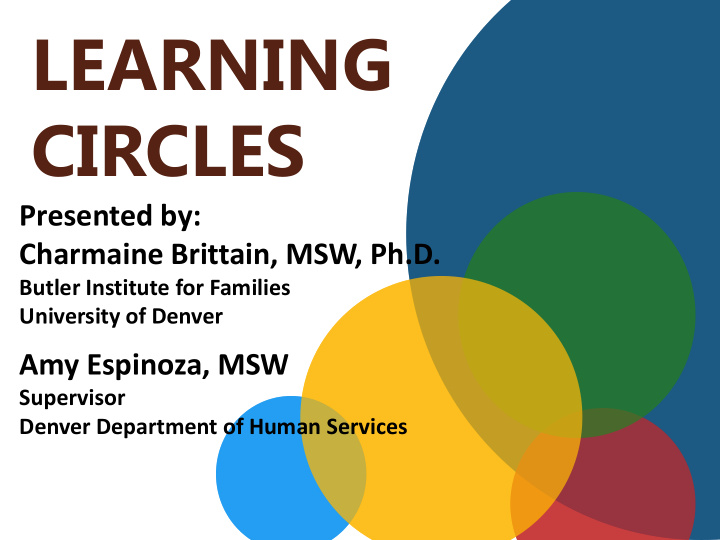



LEARNING CIRCLES Presented by: Charmaine Brittain, MSW, Ph.D. Butler Institute for Families University of Denver Amy Espinoza, MSW Supervisor Denver Department of Human Services
Introduction to Learning Circles • Learning Circles are groups that engage in a process of learning through collective inquiry. • Facilitated by a group leader. • Group members are accountable to one another. • Goal: improve outcomes by improving how things are done (our system) and what we are doing (our practice).
In Learning Circles…. The Process is as Important as the Product
Learning Circle Approach • Membership – A group of supervisors and his/her unit OR – A group of supervisors and/or managers – Designated facilitator and coach • Learning Circles use the PARA approach -- Plan-Act-Reflect-Adapt • Encourages building a learning culture through acquiring and building knowledge.
Learning Circle Process Agency priorities and information Topic LC members select topic Basket PLAN Each LC member shares topic Learning experience SEND Organization Recommendations ACT to Other Org Environment Levels ADAPT REFLECT
Learning Circle Principles Create organizational change and improved • outcomes through a focus on best practice. Inspire a learning organization committed to • improved practices, functioning, and outcomes. Address challenges or practice issues relevant to • and actionable by the Learning Circle members. Connect practice change to the agency’s mission, • values, and practice model. Employ interventions and activities based upon • evidenced-based approaches.
Learning Circle Principles • Empower circle members to improve practice for more positive organizational climate and client outcomes. • Use strengths-focused interventions. • Embody a culturally responsive approach. • Use comprehensive, incremental interventions for long-term sustainability.
Learning Circle Principles • Expect full, open, and unbiased participation that encourages communication by all members of the circle. • Empower circle members to engage in collaborative, balanced, and supportive behavior. • Emphasize ongoing evaluation to improve effectiveness and achieve desired outcomes.
HOW DO THESE PRINCIPLES MANIFEST IN THE LEARNING CIRCLE? A SUPERVISOR’S PERSPECTIVE
Learning Circle Process • Step 1: Convene the meeting. Make sure members “check” their baggage at the door. • Step 2: Acknowledge the LC Recorder for the meeting. • Step 3: Remind team members of the LC Principles— to create a learning culture. • Step 4: Facilitate a dialogue about the designated topic, remembering PARA.
Learning Circle Process • Step 5: Discuss what has been learned from the day’s Learning Circle and review the plan. • Step 6: Set the next meeting date. Adjourn the meeting. • Step 7: Complete the LC Meeting Journal and post as planned.
Evaluation Plan • To what extent are learning circles implemented with fidelity to the model? • What are the strengths and limitations of using PARA as a process for learning circles? • What topics, best practices, and goals do supervisors address in learning circles? • To what degree do agency managers and unit members perceive changes in supervisory practice as a result of learning circles?
A SUPERVISOR’S PERSPECTIVE
Topics covered in Learning Circles….. • Staff Retention • Community Partners • Use of data and research • Time Management • Foster care issues related to DJJ • Training for new staff • Resource development • Family Team meetings
Topics covered in Learning Circles….. • Case staffing • Transferring cases • Secondary trauma • Team Building • Supervision and nurturing • Dealing with difficult issues • Change • Managing upwards
Developing a Learning Circle Project 1. Convene a committee 2. Determine structure of program 3. Develop supporting materials 4. Recruit/identify learning circles 5. Train learning circle facilitators/coaches 6. Commence learning circles 7. Support learning circles 8. Conduct ongoing evaluation
QUESTIONS?
Recommend
More recommend